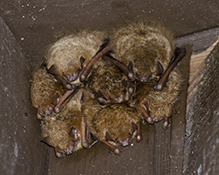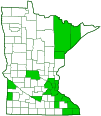tri-colored bat
(Perimyotis subflavus)
Conservation • Description • Habitat • Biology • Distribution • Taxonomy
Description |
||
Tri-colored bat, formerly called eastern pipistrelle, is a small vesper bat. It occurs in the United States east of the Great Plains, in southern Canada from Nova Scotia to Ontario, and in Mexico. It was once thought to be one of the most common bats within its range. Its numbers have declined significantly since 2006 due to spreading of the fungal disease white nose syndrome, and to mortality from wind turbines. Tri-colored bats are found in woodlands near water. They tend to avoid deep forests and open fields. They roost alone, often in trees, but also in rock crevices and in buildings. They hibernate from October to April in caves and mine tunnels, usually in the deeper parts with higher temperatures. Tri-colored bat is one of the smallest bats in eastern North America and is the smallest bat in Minnesota. Adults are 3″ to 3½″ (77 to 89 mm) in length, have an 8⅝″ to 10″ (220 to 250 mm) wingspan, and weigh 0.16 to 0.28 oz (4.6 to 7.9 g). Females are larger than males. Like most bats, they have two mammae. The fur (pelage) is usually yellowish-brown overall, but individual hairs are distinctly tri-colored: dark gray at the base, yellowish-brown in the middle, and dark brown or reddish-brown at the tip. This is the feature that gives tri-colored bat its common name and helps to distinguish it from similar species. The ears, snout, and skin are pinkish. The ears are not particularly large. The fleshy projection at the base of each ear (tragus) is short and blunt. The small size and blunt tragus distinguish tri-colored bat from all other bats in Minnesota. The skull has 34 teeth. No other bat in Minnesota has 34 teeth. The wing-like flight membrane (patagium) is composed of skin and associated tissues between the neck and the first digit of the forelimb (propatagium), between the digits of the forelimb (dactylopatagium), between the last digit and the hind limb (plagiopatagium), and between the tail and the hindlimb (uropatagium or interfemoral membrane). The membrane is blackish, and the forearm is reddish. The forearm length is 1¼″ to 1⅜″ (31.4 to 34.1 mm). The upper side of the interfemoral membrane is densely covered with fur just on the basal third. The tail extends to the end of the interfemoral membrane but not beyond it. A spur of cartilage (calcar) extends from the ankle along the outer part of the interfemoral membrane, which it helps to extend in flight. The calcar does not have a keel. |
||
Size |
||
Total length: 3″ to 3½″ (77 to 89 mm) Wingspan: 8⅝″ to 10″ (220 to 250 mm) Tail: 1⅜″ to 1⅝″ (34 to 41 mm) Forearm length: 1¼″ to 1⅜″ (31.4 to 34.1 mm) Weight: 0.16 to 0.28 oz (4.6 to 7.9 g) |
||
Sign |
||
|
||
Similar Species |
||
Habitat |
||
Woodlands |
||
Biology |
||
Behavior |
||
|
||
Lifespan |
||
4 to 8 years |
||
Life Cycle |
||
|
||
Food |
||
Moths, flies, beetles, and ants |
||
Distribution |
||||
|
Sources |
|||
| 5/7/2023 | ||||
Occurrence |
||||
|
||||
Taxonomy |
|||
| Class | Mammalia (mammals) | ||
| Subclass | Theria | ||
| Infraclass | Eutheria (placental mammals) | ||
| Magnorder | Boreoeutheria | ||
| Superorder | Laurasiatheria (ungulates, carnivorans, and allies) | ||
| Order | Chiroptera (bats) | ||
| Suborder | Yangochiroptera | ||
| Superfamily | Vespertilionoidea | ||
Family |
Vespertilionidae (evening bats) | ||
Subfamily |
Vespertilioninae (vesper bats) | ||
| Tribe | Perimyotini (tricolored and canyon bats) | ||
Genus |
Perimyotis | ||
This species was previously classified as Pipistrellus subflavus. A morphological review (Menu, 1984) contended that it was more similar to the genus Myotis, and proposed transferring it to a new genus Perimyotis. The proposal was not widely accepted. A recent molecular phylogenetics study of the family Vespertilionidae (Hoofer, 2003) showed that it does not belong in the genus Pipistrellus, and confirmed its placement in the genus Perimyotis. |
|||
Subordinate Taxa |
|||
tri-colored bat (Perimyotis subflavus clarus) tri-colored bat (Perimyotis subflavus floridanus) tri-colored bat (Perimyotis subflavus subflavus) tri-colored bat (Perimyotis subflavus veraecrucis) |
|||
Synonyms |
|||
Pipistrellus subflavus |
|||
Common Names |
|||
eastern pipistrelle tri-colored bat |
|||
Perimyotis subflavus was previously known by the common name eastern pipistrelle. It was incorrectly believed to be closely related to the European genus Pipistrellus. |
|||
Glossary
Interfemoral membrane
In some mammals, the part of the patagium that extends between the legs and the tail; uropatagium.
Patagium
In some mammals, the membrane between the forelimb and the abdomen that assists in flying or gliding. In Lepidoptera, one of a pair of hair-covered, sausage-shaped, scale-like plates on the thorax that cover the wing bases. Plural: patagia.
Pelage
The coat of a mammal, consisting of fur, wool, or hair, and including a soft undercoat and stiff guard hairs.
Tragus
The fleshy projection on the inner side of the outer ear partially covering the ear canal.
Visitor Photos |
|||||
Share your photo of this mammal. |
|||||
| This button not working for you? Simply email us at info@MinnesotaSeasons.com. Attach one or more photos and, if you like, a caption. |
|||||
Christa Rittberg |
|||||
Bats on the bathroom wall on Picnic Island in Fort Snelling State Park. |
|||||
 |
|||||
MinnesotaSeasons.com Photos |
|||||
|
|||||

Visitor Videos |
|||
Share your video of this mammal. |
|||
| This button not working for you? Simply email us at info@MinnesotaSeasons.com. Attach a video, a YouTube link, or a cloud storage link. |
|||
Other Videos |
|||
| The Bat Lair - The Tricolored Bat (Perimyotis subflavus) The Wild Life |
|||
About
Feb 1, 2021 Follow John into the bat lair to find one of the rarest bat species in Florida! |
|||
| Bat In The Patio Umbrella MyBackyardBirding |
|||
About
Apr 29, 2018 A Tri-Colored or Eastern Pipistrelle Bat (Perimyotis subflavus) roosting in the patio umbrella offers a close-up view of this seldom seen and fascinating creature. This bat is very small with a body not even two inches long and is actually quite cute. Bats are very beneficial eating mosquitoes that carry disease. These bats are so small they can easily hide in the jungle behind the Backyard under palm fronds and large leafs behind loose tree bark or in moss clumps and small cavities in trees. Interesting that they seem to have a preference for closed umbrellas. More info at: https://www.amazon.com/shop/mybackyardbirding |
|||

Visitor Sightings |
|||||
Report a sighting of this mammal. |
|||||
| This button not working for you? Simply email us at info@MinnesotaSeasons.com. Be sure to include a location. |
|||||
| Christa Rittberg 6/4/2016 |
Location: Fort Snelling State Park Bats on the bathroom wall on Picnic Island in Fort Snelling State Park. |
 |
|||
MinnesotaSeasons.com Sightings |
|||||
|
|||||

Created: 5/7/2023
Last Updated:


